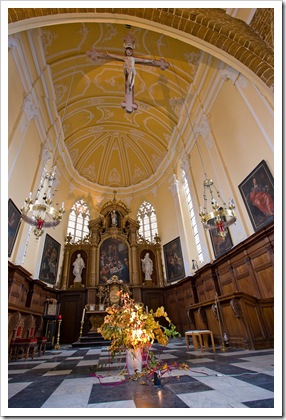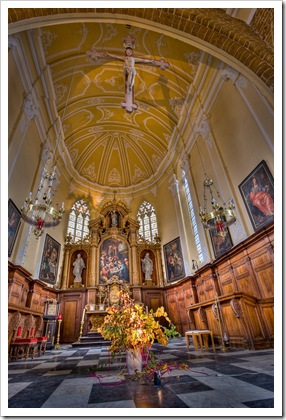How much is too much? In other words: how far can you push it in post-processing? I don’t believe there is just one answer. After all, it is a matter of personal preference, and dependent on the intent the photographer wants to express with the picture.
 Here’s an image shot in the beguinage church of Diest. The first version results from a single 12-bit RAW frame, exposed 1sec at f/5.6 at ISO 400, carefully processed in Lighroom 2.5. Click on the picture to enlarge and see more detail. Not too shabby, a good example of what you can obtain from a state-of-the-art DSLR.
Here’s an image shot in the beguinage church of Diest. The first version results from a single 12-bit RAW frame, exposed 1sec at f/5.6 at ISO 400, carefully processed in Lighroom 2.5. Click on the picture to enlarge and see more detail. Not too shabby, a good example of what you can obtain from a state-of-the-art DSLR.
 The next version is the result of 4 different RAW exposures (adding -4EV, –2EV and +2EV frames to the one used above), taken from Lightroom into Photomatix Pro 3.1 using the Exposure Blending process. There’s a lot more detail now, especially in the highlight areas, but also in shadows. Local contrast is higher and colors are more saturated. But overall the image keeps its natural photographic look – which is why I prefer this technique.
The next version is the result of 4 different RAW exposures (adding -4EV, –2EV and +2EV frames to the one used above), taken from Lightroom into Photomatix Pro 3.1 using the Exposure Blending process. There’s a lot more detail now, especially in the highlight areas, but also in shadows. Local contrast is higher and colors are more saturated. But overall the image keeps its natural photographic look – which is why I prefer this technique.
 Taking the same four frames through Photomatix Pro, this time applying the Tone Mapping method, gives a very different outcome. Less realistic for sure, but not without its own artistic quality. And I haven’t pushed the sliders that far at all!
Taking the same four frames through Photomatix Pro, this time applying the Tone Mapping method, gives a very different outcome. Less realistic for sure, but not without its own artistic quality. And I haven’t pushed the sliders that far at all!
For now, I keep my preference for the ‘natural’ look when taking the HDR route. But I will continue to experiment and explore more creative opportunities whenever there’s a hint of an interesting outcome. After all, post-processing has always been part of the fun, whether the room is dark or light…
Gear notes: D700, 17-35/2.8
Click on the image(s) to see a larger version

No comments:
Post a Comment